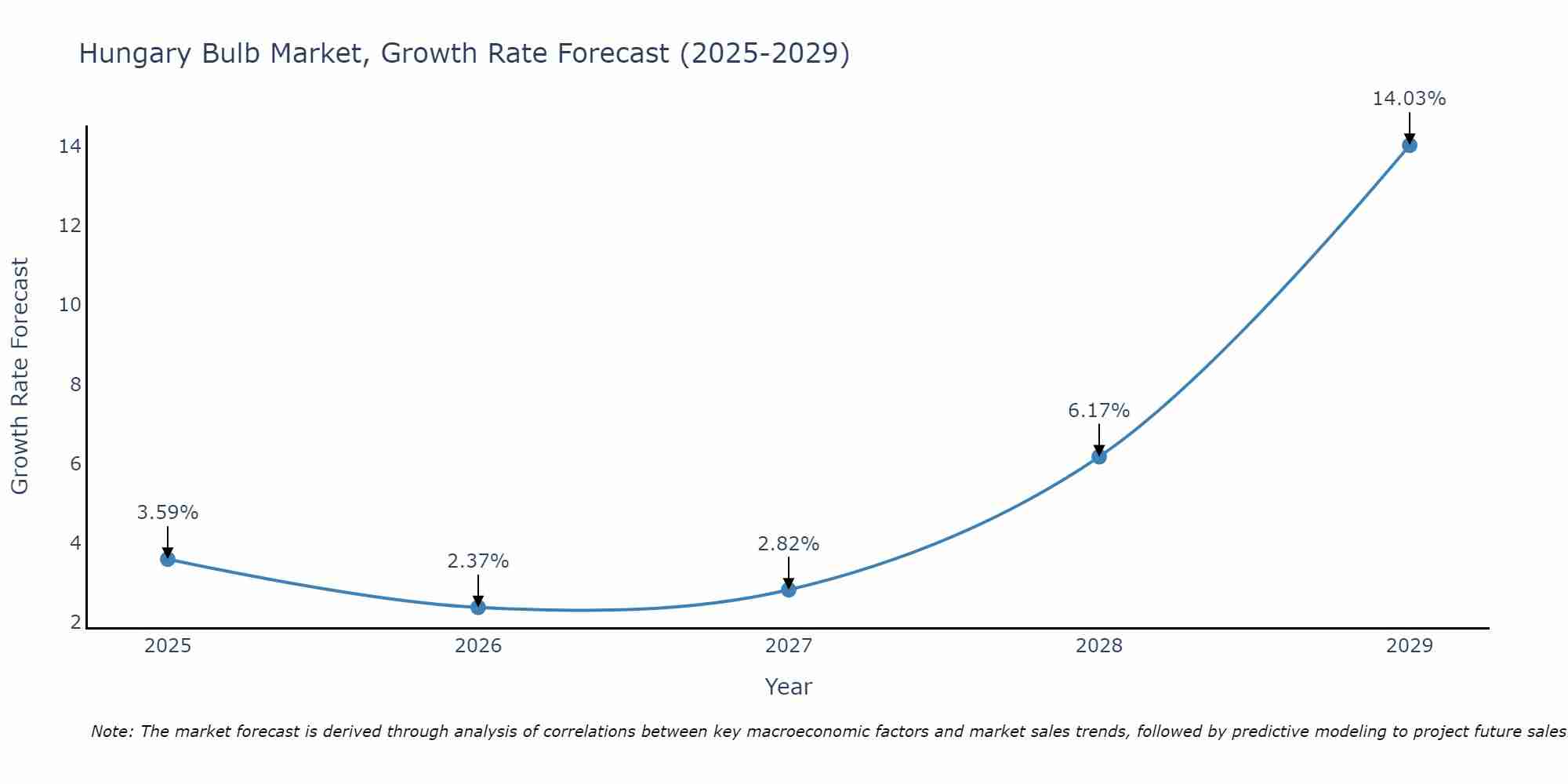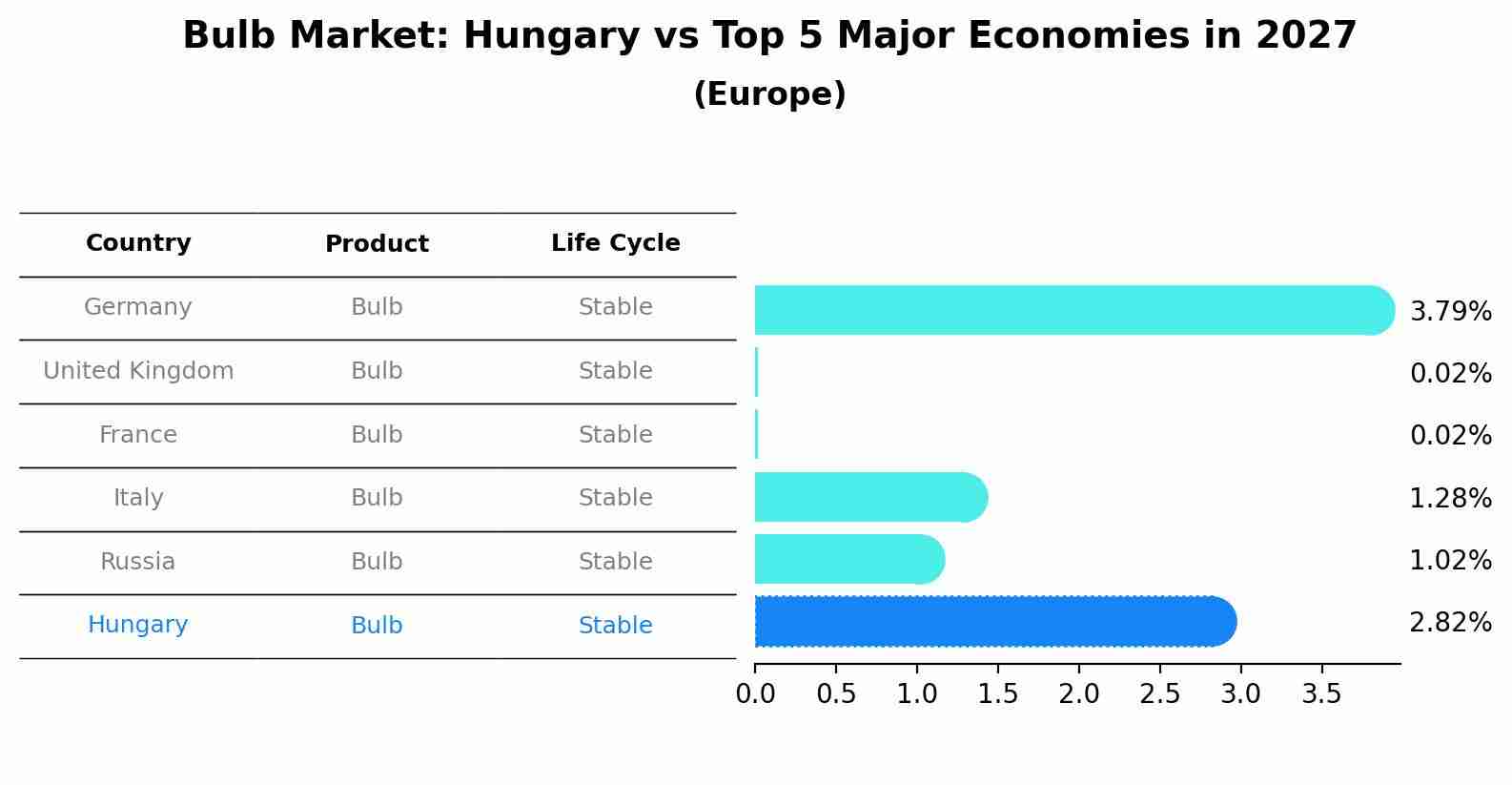Hungary Bulb Market Outlook | Revenue, Share, Forecast, Analysis, Trends, Industry, COVID-19 IMPACT, Companies, Value, Growth & Size
| Product Code: ETC258739 | Publication Date: Aug 2022 | Updated Date: Apr 2025 | Product Type: Market Research Report | |
| Publisher: 6Wresearch | No. of Pages: 75 | No. of Figures: 35 | No. of Tables: 20 | |
Hungary Bulb Market Size Growth Rate
The Hungary Bulb Market is projected to witness mixed growth rate patterns during 2025 to 2029. Commencing at 3.59% in 2025, growth builds up to 14.03% by 2029.

Bulb Market: Hungary vs Top 5 Major Economies in 2027 (Europe)
The Bulb market in Hungary is projected to grow at a stable growth rate of 2.82% by 2027, highlighting the country's increasing focus on advanced technologies within the Europe region, where Germany holds the dominant position, followed closely by United Kingdom, France, Italy and Russia, shaping overall regional demand.

Hungary Bulb Market Overview
The Hungary Bulb market encompasses various types of lighting bulbs, including incandescent, fluorescent, LED, and halogen bulbs. With the shift towards energy-efficient lighting solutions, LED bulbs are experiencing significant growth in demand due to their long lifespan and lower energy consumption. Government initiatives to phase out inefficient lighting technologies are further driving the adoption of LED bulbs in residential, commercial, and industrial sectors.
Drivers of the market
The bulb market in Hungary is undergoing transformation driven by several factors. With the shift towards energy-efficient lighting solutions, there`s a decline in traditional incandescent bulbs in favor of LED bulbs. This transition is accelerated by government policies phasing out inefficient lighting technologies to promote energy conservation. Moreover, advancements in LED technology, including increased efficiency, longer lifespan, and declining prices, make LED bulbs more attractive to consumers and businesses alike. As sustainability becomes a key consideration, the demand for eco-friendly lighting options continues to rise, reshaping the Hungary bulb market.
Challenges of the market
The Bulb market in Hungary faces competition from energy-efficient LED bulbs and regulatory measures aimed at phasing out incandescent bulbs. However, there may still be segments of the population, particularly in rural areas, where traditional incandescent bulbs remain popular due to affordability and familiarity.
Government Policy of the market
The Hungary government has been supporting the transition to energy-efficient lighting solutions to reduce electricity consumption and carbon emissions. To encourage the adoption of energy-efficient bulbs, the government has implemented regulations phasing out traditional incandescent bulbs and promoting the use of compact fluorescent lamps (CFLs) and light-emitting diodes (LEDs). These regulations often include energy performance standards and labeling requirements to guide consumers in making informed choices. Furthermore, the government may offer subsidies or rebates for the purchase of energy-efficient bulbs, making them more affordable for households and businesses. Additionally, public procurement policies prioritize the use of energy-efficient lighting in government buildings and infrastructure projects, further driving the demand for bulbs with higher energy efficiency ratings.
Key Highlights of the Report:
- Hungary Bulb Market Outlook
- Market Size of Hungary Bulb Market, 2021
- Forecast of Hungary Bulb Market, 2028
- Historical Data and Forecast of Hungary Bulb Revenues & Volume for the Period 2018 - 2028
- Hungary Bulb Market Trend Evolution
- Hungary Bulb Market Drivers and Challenges
- Hungary Bulb Price Trends
- Hungary Bulb Porter's Five Forces
- Hungary Bulb Industry Life Cycle
- Historical Data and Forecast of Hungary Bulb Market Revenues & Volume By Type for the Period 2018 - 2028
- Historical Data and Forecast of Hungary Bulb Market Revenues & Volume By Incandescent Bulbs for the Period 2018 - 2028
- Historical Data and Forecast of Hungary Bulb Market Revenues & Volume By Fluorescent Bulbs for the Period 2018 - 2028
- Historical Data and Forecast of Hungary Bulb Market Revenues & Volume By CFLs for the Period 2018 - 2028
- Historical Data and Forecast of Hungary Bulb Market Revenues & Volume By Halogens for the Period 2018 - 2028
- Historical Data and Forecast of Hungary Bulb Market Revenues & Volume By LEDs for the Period 2018 - 2028
- Historical Data and Forecast of Hungary Bulb Market Revenues & Volume By Application for the Period 2018 - 2028
- Historical Data and Forecast of Hungary Bulb Market Revenues & Volume By Lamps & Light Bulbs for the Period 2018 - 2028
- Historical Data and Forecast of Hungary Bulb Market Revenues & Volume By Operation Theatre (OT Instruments) for the Period 2018 - 2028
- Historical Data and Forecast of Hungary Bulb Market Revenues & Volume By Torchlights and Flashlights for the Period 2018 - 2028
- Historical Data and Forecast of Hungary Bulb Market Revenues & Volume By Automobile Headlights for the Period 2018 - 2028
- Historical Data and Forecast of Hungary Bulb Market Revenues & Volume By Mining Headgears for the Period 2018 - 2028
- Historical Data and Forecast of Hungary Bulb Market Revenues & Volume By Others for the Period 2018 - 2028
- Hungary Bulb Import Export Trade Statistics
- Market Opportunity Assessment By Type
- Market Opportunity Assessment By Application
- Hungary Bulb Top Companies Market Share
- Hungary Bulb Competitive Benchmarking By Technical and Operational Parameters
- Hungary Bulb Company Profiles
- Hungary Bulb Key Strategic Recommendations
Frequently Asked Questions About the Market Study (FAQs):
1 Executive Summary |
2 Introduction |
2.1 Key Highlights of the Report |
2.2 Report Description |
2.3 Market Scope & Segmentation |
2.4 Research Methodology |
2.5 Assumptions |
3 Hungary Bulb Market Overview |
3.1 Hungary Country Macro Economic Indicators |
3.2 Hungary Bulb Market Revenues & Volume, 2021 & 2028F |
3.3 Hungary Bulb Market - Industry Life Cycle |
3.4 Hungary Bulb Market - Porter's Five Forces |
3.5 Hungary Bulb Market Revenues & Volume Share, By Type, 2021 & 2028F |
3.6 Hungary Bulb Market Revenues & Volume Share, By Application, 2021 & 2028F |
4 Hungary Bulb Market Dynamics |
4.1 Impact Analysis |
4.2 Market Drivers |
4.3 Market Restraints |
5 Hungary Bulb Market Trends |
6 Hungary Bulb Market, By Types |
6.1 Hungary Bulb Market, By Type |
6.1.1 Overview and Analysis |
6.1.2 Hungary Bulb Market Revenues & Volume, By Type, 2018 - 2028F |
6.1.3 Hungary Bulb Market Revenues & Volume, By Incandescent Bulbs, 2018 - 2028F |
6.1.4 Hungary Bulb Market Revenues & Volume, By Fluorescent Bulbs, 2018 - 2028F |
6.1.5 Hungary Bulb Market Revenues & Volume, By CFLs, 2018 - 2028F |
6.1.6 Hungary Bulb Market Revenues & Volume, By Halogens, 2018 - 2028F |
6.1.7 Hungary Bulb Market Revenues & Volume, By LEDs, 2018 - 2028F |
6.2 Hungary Bulb Market, By Application |
6.2.1 Overview and Analysis |
6.2.2 Hungary Bulb Market Revenues & Volume, By Lamps & Light Bulbs, 2018 - 2028F |
6.2.3 Hungary Bulb Market Revenues & Volume, By Operation Theatre (OT Instruments), 2018 - 2028F |
6.2.4 Hungary Bulb Market Revenues & Volume, By Torchlights and Flashlights, 2018 - 2028F |
6.2.5 Hungary Bulb Market Revenues & Volume, By Automobile Headlights, 2018 - 2028F |
6.2.6 Hungary Bulb Market Revenues & Volume, By Mining Headgears, 2018 - 2028F |
6.2.7 Hungary Bulb Market Revenues & Volume, By Others, 2018 - 2028F |
7 Hungary Bulb Market Import-Export Trade Statistics |
7.1 Hungary Bulb Market Export to Major Countries |
7.2 Hungary Bulb Market Imports from Major Countries |
8 Hungary Bulb Market Key Performance Indicators |
9 Hungary Bulb Market - Opportunity Assessment |
9.1 Hungary Bulb Market Opportunity Assessment, By Type, 2021 & 2028F |
9.2 Hungary Bulb Market Opportunity Assessment, By Application, 2021 & 2028F |
10 Hungary Bulb Market - Competitive Landscape |
10.1 Hungary Bulb Market Revenue Share, By Companies, 2021 |
10.2 Hungary Bulb Market Competitive Benchmarking, By Operating and Technical Parameters |
11 Company Profiles |
12 Recommendations |
13 Disclaimer |
- Single User License$ 1,995
- Department License$ 2,400
- Site License$ 3,120
- Global License$ 3,795
Search
Related Reports
- Portugal Electronic Document Management Market (2025-2031) | Strategy, Consumer Insights, Analysis, Investment Trends, Opportunities, Growth, Size, Share, Industry, Revenue, Segments, Value, Segmentation, Supply, Forecast, Restraints, Outlook, Competition, Drivers, Trends, Demand, Pricing Analysis, Competitive, Strategic Insights, Companies, Challenges
- France Electronic Document Management Market (2025-2031) | Strategy, Consumer Insights, Analysis, Investment Trends, Opportunities, Growth, Size, Share, Industry, Revenue, Segments, Value, Segmentation, Supply, Forecast, Restraints, Outlook, Competition, Drivers, Trends, Demand, Pricing Analysis, Competitive, Strategic Insights, Companies, Challenges
- Portugal Occupational Health & Safety Services Market (2025-2031) | Strategy, Consumer Insights, Analysis, Investment Trends, Opportunities, Growth, Size, Share, Industry, Revenue, Segments, Value, Segmentation, Supply, Forecast, Restraints, Outlook, Competition, Drivers, Trends, Demand, Pricing Analysis, Competitive, Strategic Insights, Companies, Challenges
- Netherlands Occupational Health and Safety Services Market (2025-2031) | Strategy, Consumer Insights, Analysis, Investment Trends, Opportunities, Growth, Size, Share, Industry, Revenue, Segments, Value, Segmentation, Supply, Forecast, Restraints, Outlook, Competition, Drivers, Trends, Demand, Pricing Analysis, Competitive, Strategic Insights, Companies, Challenges
- Belgium and Luxembourg Facility Management Market (2025-2031) | Strategy, Consumer Insights, Analysis, Investment Trends, Opportunities, Growth, Size, Share, Industry, Revenue, Segments, Value, Segmentation, Supply, Forecast, Restraints, Outlook, Competition, Drivers, Trends, Demand, Pricing Analysis, Competitive, Strategic Insights, Companies, Challenges
- Russia Women Intimate Apparel Market (2025-2031) | Strategy, Consumer Insights, Analysis, Investment Trends, Opportunities, Growth, Size, Share, Industry, Revenue, Segments, Value, Segmentation, Supply, Forecast, Restraints, Outlook, Competition, Drivers, Trends, Demand, Pricing Analysis, Competitive, Strategic Insights, Companies, Challenges
- Africa Chocolate Market (2025-2031) | Size, Share, Trends, Growth, Revenue, Analysis, Forecast, industry & Outlook
- Global Hydroxychloroquine And Chloroquine Market (2025-2031) | Industry, Trends, Size, Outlook, Growth, Value, Companies, Revenue, Analysis, Share, Forecast
- Saudi Arabia Plant Maintenance Market (2025-2031) | Industry, Size, Growth, Revenue, Value, Companies, Forecast, Analysis, Share & Trends
- Taiwan Electric Truck Market (2025-2031) | Outlook, Industry, Revenue, Size, Forecast, Growth, Analysis, Share, Companies, Value & Trends
Industry Events and Analyst Meet
Our Clients
Whitepaper
- Middle East & Africa Commercial Security Market Click here to view more.
- Middle East & Africa Fire Safety Systems & Equipment Market Click here to view more.
- GCC Drone Market Click here to view more.
- Middle East Lighting Fixture Market Click here to view more.
- GCC Physical & Perimeter Security Market Click here to view more.
6WResearch In News
- Doha a strategic location for EV manufacturing hub: IPA Qatar
- Demand for luxury TVs surging in the GCC, says Samsung
- Empowering Growth: The Thriving Journey of Bangladesh’s Cable Industry
- Demand for luxury TVs surging in the GCC, says Samsung
- Video call with a traditional healer? Once unthinkable, it’s now common in South Africa
- Intelligent Buildings To Smooth GCC’s Path To Net Zero













